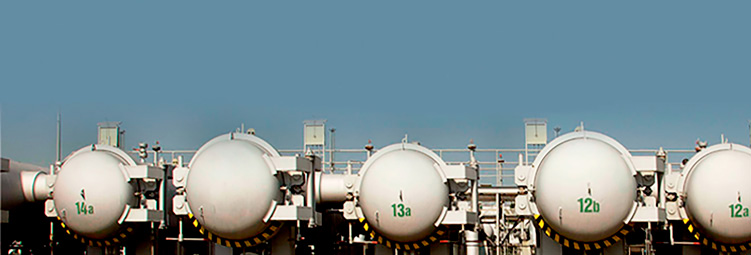
History
The history of NET4GAS is a story of economically efficient, safe and reliable transmission services provided to customers 24 hours a day, 7 days a week. Thanks to its advantageous location in the heart of Europe, Czechoslovakia and later on the Czech Republic has always played an important role on the European gas market.
First thoughts of transit through Czechoslovakia
The first records of the export of Russian natural gas to Central and Western Europe were published in the mid-1960s. The possibility of export was at first rejected by the Russian side due to the objective rationalization of falling production in Ukraine, and later it was confirmed, but only in the amount of 1 billion cubic meters per year for the whole of former Czechoslovakia. Based on this decision, construction of the first international gas pipeline called Bratrství (“Brotherhood”) with a nominal diameter of 700 mm and a nominal pressure of 5.5 MPa was started. It was put into operation in 1967, beginning the distribution of Russian natural gas in Czechoslovakia (Slovakia and South Moravia) and consequently the first transit testing of this gas to Austria. This resulted in the transition from coal gas to natural gas in Czechoslovakia.
The further development of Russian gas supplies to Central and Western Europe was considered in several scenarios. After technical and political negotiations, it was decided in 1970 that the gas pipeline for the supplies would lead through Czechoslovakia. After this decision had been made, further progress was unusually quick. And it was Transgas, which contributed to its execution in the following years.
Foundation and transmission system development in Czechoslovakia
Following the intergovernmental agreement of December 1970, the national enterprise Tranzitní plynovod Praha (operating abroad under the name of Transgas) was founded in April 1971. It was charged with being the direct investor and operator of the future gas transit system. Over the next two years, approximately 1,100 km of DN 1200 and DN 900 gas pipelines and three compressor stations were built and put into operation in order to meet the deadlines of the first gas transmission to Austria (Baumgarten), West Germany (Waidhaus), and East Germany (Hora Svaté Kateřiny).
The oil crisis in 1973 emphasized the importance of natural gas as an alternative clean energy from a new source. After the first phase of the construction of the transit gas pipeline, other phases followed, gradually increasing the performance of the system. This was also connected with the requirements of higher gas pipeline capacities in the former USSR, in the construction of which Transgas also participated.
The growth rate in the transmission capacity of the Czechoslovak natural gas transit system in the 1980s and 1990s was stunning. Of the original 28.0 billion m3 per year, which many thought would be the long-term final volume, transport capacity gradually increased during the period to 80.0 billion m3 per year.
Separation of Czechoslovakia
As of 1 January 1993, Czechoslovakia was divided into two separate countries – the Czech Republic and the Slovak Republic. The same date was also the date of asset allocation for the Czechoslovak transit system on a territorial basis. The same principle was also used in dividing the transit contracts. Completion of the commercial division of the Czechoslovak transit system took place one year later, on 1 January 1994, when a new border transfer station was put into operation at the Czech-Slovak border at Lanžhot.
Recent history
In 2001, the Czech government decided to privatize the Czech gas industry and RWE Gas became the new shareholder of the company. As a result of legislative requirements for “legal unbundling”, the TSO business was separated and began operations as RWE Transgas Net, s.r.o. from 2006. In 2010, RWE Transgas Net was re-named NET4GAS, s.r.o. as part of a continuing process of unbundling gas transmission from gas trading activities, in compliance with the regulatory policy of the European Union, which required the complete separation of branding strategies for transmission activities from the trading activities of vertically integrated gas companies.
In 2013, the RWE Group sold its shares to a consortium of Allianz Capital Partners and Borealis Infrastructure. Since December 2023, NET4GAS is owned by ČEPS a.s. ČEPS, a joint stock company, is the sole Czech Transmission System Operator and holds an exclusive licence to that effect granted by the Energy Regulatory Office.
New connections in Central Europe
Until the late 1990s, the transit corridor through Ukraine, Slovakia and the Czech Republic / Austria was the only export route for Russian natural gas to Europe. In 1999, the YAMAL pipeline through Poland started operation, denoting the starting point for the partial shift of Russian gas export to new routes. This trend continued in 2011/2012 with the implementation of the Nord Stream pipeline project through the Baltic Sea and its connection to the Czech gas transmission system via the OPAL pipeline in Germany. For this purpose, NET4GAS built the GAZELLE pipeline together with the Brandov Border Transfer Station, one of the largest energy infrastructure investments in the Czech Republic in recent years.
In order to further increase the security of energy supplies in Europe, from 2011 to 2015 NET4GAS carried out additional projects aimed at enhancing reverse flow capacities in the West-East direction and improving connections with underground gas storage facilities as well as with neighbouring transmission system operators.
NET4GAS continues to play an active role in connecting and integrating European gas markets, enabling the connection of the Czech transmission system to new supply routes and sources of natural gas.

